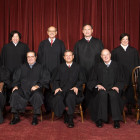

An 11-year-old denied making a threat and was allowed to return to school. Tennessee police arrested him anyway.
|
In late September, Torri was driving down the highway with her 11-year-old son Junior in the back seat when her phone started ringing.
It was the Hamilton County Sheriff’s deputy who worked at Junior’s middle school in Chattanooga, Tennessee. Deputy Arthur Richardson asked Torri where she was. She told him she was on the way to a family birthday dinner at LongHorn Steakhouse.
“He said, ‘Is Junior with you?’” Torri recalled.
Earlier that day, Junior had been accused by other students of making a threat against the school. When Torri had come to pick him up, she’d spoken with Richardson and with administrators, who’d told her he was allowed to return to class the next day. The principal had said she would carry out an investigation then. ProPublica and WPLN are using a nickname for Junior and not including Torri’s last name at the family’s request, to prevent him from being identifiable.
When Richardson called her in the car, Torri immediately felt uneasy. He didn’t say much before hanging up, and she thought about turning around to go home. But she kept driving. When they walked into the restaurant, Torri watched as Junior happily greeted his family.
Soon her phone rang again. It was the deputy. He said he was outside in the strip mall’s parking lot and needed to talk to Junior. Torri called Junior’s stepdad, Kevin Boyer, for extra support, putting him on speaker as she went outside to talk to Richardson. She left Junior with the family, wanting to protect her son for as long as she could ...

High Court Ruling on Juvenile Life Without Parole Could Impact Many
|
Hundreds of people like Alabama’s Evan Miller are newly-eligible to appear in front of sentencing judges and perhaps parole boards, as the U.S. Supreme Court strikes down certain life sentences without parole that were handed out to juvenile offenders. As a drug-addicted, abused, neglected minor in and out of foster care, 14-year-old Miller and a friend, killed his mother’s drug dealer in 2003 after an evening of sharing drink and drugs. Under a mandatory sentencing law that ignores mitigating factors, Alabama sent Miller to prison for life without the chance of parole. But now minors like Miller must be allowed to present mitigating circumstances and the sentencing judge or jury must pay attention, the court ruled on July 25 in Miller v. Alabama. “Its kind of a new procedure that I think is going to be imposed in some jurisdictions,” said Richard Broughton, Assistant Professor of Law at the University of Detroit’s Mercy School of Law.

Justices’ Ruling on Young Killers Eases Anxieties for Some Experts, Advocates
|
By Eric Ferkenhoff and Maggie Lee
The violence that stains Chicago is a long way from Washington, D.C., where the U.S. Supreme Court ruled Monday it was not just to lock up juvenile killers for life without parole in most cases. The court, reasoning children should not face what amounts to death behind bars, voted 5-4. Monday’s decision had been anticipated since arguments were heard in March on two cases out of Alabama and Arkansas dealing with 14-year-old convicts, and won the applause of children’s and rights advocates and scorn from those who believe punishment should be equal to the crime. “I’m feeling very good, hopeful,” said Julie Anderson, 55, whose son was convicted of murder at 15 in 1995. “We’ll see how it plays out, but my son defintely qualifiies under this ruling to have his sentence looked at again.”
She added: “And there’s so many of them, these people who were only children.

Supreme Court Forbids Mandatory Life Sentences Without Parole for Juveniles
|
UPDATED Tuesday, 9:23 a.m.: WASHINGTON - Advocates for juvenile justice reform applauded the U.S. Supreme Court’s landmark 5-to-4 ruling yesterday that children under 18 could not be handed life imprisonment sentences without hope of release – even if convicted of murder – without taking into account their age and other extenuating circumstances at the time of the crime. “Held: The Eighth Amendment forbids a sentencing scheme that mandates life in prison without possibility of parole for juvenile homicide offenders,” read the majority opinion written by Justice Elena Kagan, which combined the court’s ruling on two cases, Jackson v. Hobbs and Miller v. Alabama. Chief Justice John Roberts wrote the dissenting opinion, joined by Justices Samuel Alito, Antonin Scalia and Clarence Thomas, sharply disagreeing that such sentences constituted cruel and unusual punishment for what were “heinous” crimes to society. “Put simply, if a 17-year-old is convicted of deliberately murdering an innocent victim, it is not ‘unusual’ for the murderer to receive a mandatory sentence of life without parole,” Roberts wrote. Kagan responded in a footnote to her opinion that she finds it ironic that the dissenters are holding a 14-year-old’s actions to the same standard as a 17-year-old’s, given that the main finding of the majority is that courts must take individual circumstances into account before deciding on a sentence.

BREAKING: Supreme Court Strikes Down Juvenile Mandatory LWOP
|
Updated: 12:07 p.m. In a 5-4 decision issued Monday morning, the Supreme Court ruled the Eighth Amendment prohibits mandatory sentences of life without possibility of parole for juveniles (JLWOP). The decision stems from two cases—Jackson v Hobbs and Miller v Alabama—involving 14-year-olds convicted of murder and sentenced to mandatory life terms.
Justice Elena Kagan wrote the majority opinion, holding that mandatory JLWOP violates the Eighth Amendment’s prohibition of cruel and unusual punishment, citing as precedent Roper v Simmons. “That right ‘flows from the basic “precept of justice that punishment for crime should be graduated and proportioned,” to both the offender and the offense,’ ” Kagan wrote. Chief Justice John Roberts wrote the dissenting opinion.

Finding the Time to Make Real Change in Juvenile Justice
|
It is a fundamental principle in effective supervision of juvenile offenders that the optimal caseload size should be 25. It is still common throughout the country to find caseloads exceeding 60 and sometimes more than 100. When I took the bench in 1999, our caseload size was 150 - it was not pretty! Today, it’s 25. The kids who scare us get intensive supervision, the kids who make us mad are referred to a system of care for services.

Citizen Advisers for State Juvenile Justice Programs Gather in DC
|
WASHINGTON - A mix of around 250 child welfare workers, law enforcement officials, public officials and nonprofit employees from 49 states and territories, many of whom advise their local agencies on preventing juvenile delinquency and improving juvenile justice systems, are convening near Washington, D.C., this weekend to lobby their federal legislators and share best practices at a time of shrinking state budgets. This year’s conference and meeting of the Council of State Advisory Groups, organized by the Coalition for Juvenile Justice, will train new state advisory group members on federal requirements under the Juvenile Justice and Delinquency Prevention Act, tackle common challenges like recruiting enough members under the age of 24 to meet federal quotas, and emphasize how members can use research data about proven outcomes to improve their programs and measure performance. Clema Lewis, co-director of a domestic violence coalition in the Virgin Islands, was among the attendees at a training session for new advisory group members this morning. Although she’s been a part of the advisory group for the last 12 years – and now serves as its chairperson -- this was the first such training she had ever attended, she said. Coming to a conference like this helps her keep up to date on the latest research, network with other people with similar challenges, and most importantly, take that information back home to share with her peers, Lewis said.



